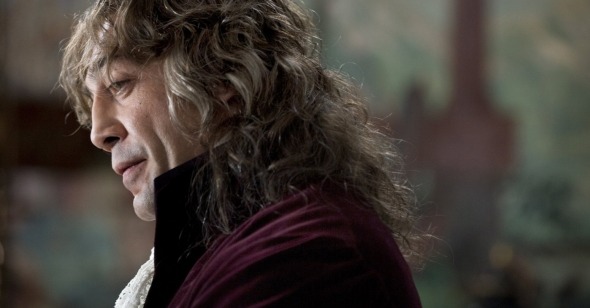Paint by Numbers
by Michael Joshua Rowin
Goya’s Ghosts
Dir. Milos Forman, U.S./Spain, Samuel Goldwyn
Goya’s Ghosts is half what one expects from Milos Forman. As in the director’s One Flew Over the Cuckoo’s Nest, Amadeus, The People vs. Larry Flynt, and Man on the Moon, its protagonist is a daring iconoclast who stands intrepid against the uncomprehending conventionalists of his time. But it significantly departs from those earlier films by making its hero more an observer than an instigator. In fact, the film travels a surprising route, moving from the controversial nature of Francisco Goya’s art to the repressive tactics of the Spanish Inquisition in its waning days in the late eighteenth century to the hypocrisy of the Napoleonic invasion and occupation of Spain. By film’s end, Goya is deaf, still able to paint the madness around him, yet impotent to help those who need him.
But whether the film benefits from placing Goya (Stellan Skarsgârd) on the sidelines is hard to say. It’s certainly refreshing to see Forman, who wrote the film with legendary screenwriter and Buñuel partner-in-crime Jean-Claude Carrière, forgo his usual tendency of beating viewers over the head in order to convince them of the immaculate saintliness of his outsider heroes. The film’s most interesting character and real subject of study is instead Brother Lorenzo, Goya’s friend and Church opportunist. Javier Bardem plays this two-faced weasel with subtle cunning, purring his words with seductive gentleness as he uses them to lie and cover his ass. His cynical enforcement of Church doctrine indirectly leads to the arrest of Inès (Natalie Portman), a Goya model falsely accused of practicing Jewish customs. Inès’s father proves to Lorenzo that her confession means nothing by feeding him his own medicine, transforming a friendly dinner into a torture chamber in which the priest is “put to the question” with rope and a chandelier serving as a pulley. Blackmailed into convincing the Church to free Inès, Lorenzo fails to do so and is disgraced. Flash forward fifteen years later and he’s now a leader of the French Revolution, denouncing the holy men who ran him out of Spain and encouraging a new reign of terror under the banner of “Liberté, Egalité, Fraternité.”
Unfortunately, things start getting a little silly and, in typical Forman fashion, more than a little overwrought when Goya’s Ghosts arrives at the Napoleonic War. A telegraphed allusion is made to the Iraq War when a French general promises his troops they will be greeted with “flowers and kisses.” (Guess what? They aren’t.) Randy Quaid makes one appearance too many as an unfunny and non-satirical King Carlos IV. And just when you thought things couldn’t venture further from the story of Goya and his role as both the King’s official painter and the people’s macabre sketch artist, the film becomes a melodramatic family affair, with the newly liberated and half-mad Inès trying, with assistance from Goya, to locate the young harlot Alicia, the daughter she conceived with Lorenzo (mainly so she can be restored sans broken jaw, greasy hair, and peeling skin, Portman also plays Alicia).
Lorenzo doesn’t want evidence of his past indiscretions to surface and so uses his power to get Alicia out of the country, which leads the film down a series of tedious twists and turns whose unimportance is conveyed through the hollow pomp of period costumes, unidentifiable accents, and a perfunctory visual palette. And yet, after all the nonsense, Forman sneaks in a final scene that conveys true weight: with the Spanish monarchy restored, a public execution becomes the stage on which Lorenzo and Inès form a grotesque reunion that mocks the righteousness of political and religious fanaticism. It’s a haunting ending to an otherwise unremarkable film, all the more powerful for taking one completely unawares.
